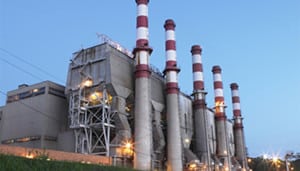Warming Climate Likely to Have “Minor” Impact on Power Plant Output
According to a Duke University study, future climate warming will likely cause only minor reductions in power output at most U.S. coal- and gas-fired power plants.
The study—which researchers say is the first of its kind based on real-world data—rebuts recent modeling-based studies that warn rising temperatures will significantly lower the efficiency of power plants’ cooling systems, thereby reducing plants’ power output. Those studies estimated that plant efficiencies could drop by as much as 1.3% for each 1 degree Celsius of climate warming.
“Our data suggest that drops in efficiency at plants with open-loop, or once-through, cooling systems will be a full order of magnitude smaller than this,” said Candise L. Henry, a doctoral student at Duke’s Nicholas School of the Environment. “Reductions at plants with wet-circulation, or closed-loop, systems—which can be identified by their cooling towers—may be even smaller.”
“In large part, this is because plant operators are already constantly adjusting operations to optimize plant performance under changing environmental conditions,” she said. “That’s a key consideration the past studies overlooked.”
The new findings do not, however, signal an all’s clear for the power industry, the Duke researchers cautioned.
“The impact of future droughts associated with global warming could still significantly affect plant operations and output by reducing the availability of water for cooling,” said Lincoln F. Pratson, Semans-Brown Professor of Earth and Ocean Sciences at Duke.
Henry and Pratson published “Effects of Environmental Temperature Change on the Efficiency of Coal- and Natural-Gas-Fired Power Plants,” August 1 in the peer-reviewed journal Environmental Science & Technology.
To conduct their study, they analyzed hourly temperature and humidity data recorded at National Climatic Data Center (NCDC) stations and U.S. Geological Survey river gauges near 39 U.S. coal- or natural gas–fired power plants over a seven- to 14-year period. By correlating this data with the plants’ hourly heat input and power output records, obtained through the Environmental Protection Agency’s (EPA’s) Air Markets Program Data website, they were able to extrapolate how much of each plant’s output was the result of daily and seasonal variations in temperature.

“These variations exceed estimates of the average future annual increase in warming under a moderate global warming scenario,” Henry noted, “so we could actually see—based on empirical evidence—how plants’ operations are affected by temperature changes much more dramatic than what is projected to occur.”
To ensure a representative sample, the study included both closed-loop and open-loop plants from the Northeast, Mid-Atlantic, Southeast, Midwest, Deep South, Great Plains, and Rocky Mountain regions. Plant capacities ranged from less than 500 MW to 3,000 MW.
The cooling efficiency and output of every plant—regardless of location, generating capacity, or fuel type—was found to be more resilient to climate warming than previous studies predicted.
Plants with closed-loop cooling systems were found to be particularly resilient.
Researchers say their study “provides additional rationale” for the EPA’s “Cooling Water Rule” based on Section 316(b) of the Clean Water Act, which requires most generators to install closed-loop recirculating systems (although other options may be better suited to specific sites).
“The EPA enacted section 316b to protect fish, shellfish and other aquatic animals from being pulled into, and harmed or killed in power plants’ cooling water-intake structures,” Pratson noted. The new study shows that 316(b) could also help protect power plants from the impact of climate warming.
—Gail Reitenbach, PhD, editor (@GailReit, @POWERmagazine)